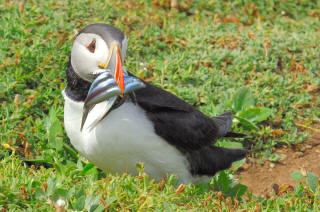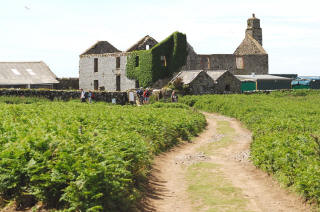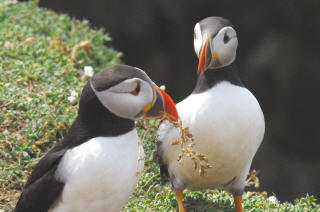Skomer Island
Skomer Island, Pembrokeshire
|

Featured Location Guide |
| To many Skomer and Puffins go together, but
there is more to Skomer than the Puffins that the majority of the visitors
go out to see, with colourful flower displays, other wildlife including a
variety of birds, seals, rabbits and its own sub species the Skomer Vole, a
subspecies of the Bank Vole. When I
visited I took photographs of a wide variety of birds, many of which I
had never seen before as well as a Peregrine, Seals and of course many
cards full of Puffins.
It is the second largest
island in Wales, after Anglesey, and one of the most important wildlife
sites in Europe. Skomer lies just off the Pembrokeshire coast, separated
from the mainland by the turbulent waters of the Jack Sound. Skomer measures
730-or-so acres (292 hectares) is 2 miles east to west, and almost 1.5
miles, north to south. The central ridge of the island reaches 260 feet
high. On a calm day the waters of Skomer are crystal clear. Skomerís waters
are Walesí only statutory Marine Nature Reserve, and one of only three in
the UK. Coral grows offshore, fed by the rich flow of the warm
Gulf Stream. Over seventy species of sponges have been recorded here.
During Springtime, Skomer is
carpeted with flowers: Bluebells as far as the eye can see, coastal
flowers (sea and red campion, pink thrift providing many red, white and pink
flowers), and with no trees on Skomer this presents a wonderful
coloured carpet for the birds to land on. Autumn brings purple
heather and yellow Ragwort.
Wildlife
It has a great diversity
of wildlife due to its geography. Half a million seabirds nest here each year.
The island's isolation has meant that mammalian ground predators such as rats,
cats, dogs and foxes are absent. This is one of the major reasons for the
island's importance as a breeding ground for burrow nesting seabirds.
Puffins can be seen on Skomer from April until
August, though in early April they may be here in large numbers on one day with
none the next, until they settle mid-month.
Mid-June to mid-July is the best time to see and
photograph big numbers, with around 6,000 pairs present, as parents are
busy delivering food for their chicks. Numbers are also swelled then by birds
too young to breed but are prospecting for the future. By the first week in
August only a handful remain, and these are soon to depart, leaving the Puffin
colonies deserted again until the following spring.
Skomer is probably the most important breeding
site of Manx Shearwaters in the world, with an estimated population of 165,000
pairs. It is difficult to find spots on the island which are not burrowed by
them, the rabbits and Puffins. The night time is also dramatic as tens of
thousands of nocturnal Manx shearwaters return to their burrows, skimming the
air like half-seen shadows and tumbling clumsily to the ground. With so many
birds all calling at once, the intensity of their discordant cries smothers the
island in a blanket of noise.
Other birds present in large numbers are
Guillemots (14,000 individuals), Razorbills (3,500 individuals), Fulmars
(700 pairs) and gulls, Kittiwakes (2,000 pairs), the smallest, the Lesser
Black-backed Gulls (11,000 pairs), Herring Gulls (460 pairs) and the
enormously big Great Black-backed Gulls (over 80 pairs), Curlews,
Short-Eared Owls (who prey on the unique Skomer Vole), Buzzards, Kestrels,
Peregrine and Oystercatchers also make their home here.
Midland Island, which
separates Skomer and the mainland, is home to a colony of Shags (over 30
pairs). About 16 pairs of Cormorants nest on the Mew Stone, to the south of
the island.
|
 |
 |
 |

Click on images to see
larger version
 For all Images on this Page
For all Images on this Page |
Visiting birds use Skomer as a stop-over,
amongst others Finches, Skylarks, Swallows, Chiffchaffs and Meadow Pipits, as
well as the occasional rare bird such as the Golden Oriole, Tawny Pipit, a
variety of Warblers, the Black Stork and the Frigate Bird. But of course a lot
of these will not be seen by the day visitor.
There are a very large number of
rabbits.
 They were introduced around 1400 AD as a source of meat and fur. They have
burrowed the island extensively, to the advantage of the Shearwaters and Puffins, which nest
in burrows. Bigger species of gulls feast on the rabbits and the other
interesting mammal on the island, the Skomer Vole, a subspecies of the Bank
Vole. It is unique to the island, and there's a unique opportunity to see all
three species of Stick Insect.
They were introduced around 1400 AD as a source of meat and fur. They have
burrowed the island extensively, to the advantage of the Shearwaters and Puffins, which nest
in burrows. Bigger species of gulls feast on the rabbits and the other
interesting mammal on the island, the Skomer Vole, a subspecies of the Bank
Vole. It is unique to the island, and there's a unique opportunity to see all
three species of Stick Insect.
Grey seals (around 200) can be seen most if not
all of the time, and found breeding around Skomer every Autumn. They are
outnumbered in Wales only by the colony which breeds around Ramsey Island, not
too far away to the north, just off the coast at St. David's.
Porpoises and Dolphins can be seen off Skomer
almost all year round. Look for Gannets fishing (they prefer the same fishing
grounds) and try to spot the inconspicuous dorsal fins, the tidal races around
the island are the best places to go.
Man on the island
Evidence of occupation by man from the Iron Age
onwards is abundant, most of Skomer is an Ancient Monument. The island is
believed to have supported an Iron Age community of up to 200 people. From the
7th century on a modern field system was gradually put in place in the centre of
the island, which has supported a single farm until 1950.
In the early 1800's a farmhouse was built in the centre of the island, but by
about 1880 refrigerated steam ships began bringing in meat and dairy
produce from overseas and farming on Skomer was no longer profitable. In
1954 a great storm badly damaged the roof of the farmhouse which, not repaired,
soon caused the building to become a ruin. Recently plans were put forward to
restore the farmhouse. Some of the outbuildings are currently in use as
accommodation for visitors and volunteers working on the island. A small number
of paying visitors are allowed to stay the night in
self catering accommodation
 run by the Wildlife Trust South & West Wales.
One of the attractions is the experience of over 300,000 Manx Shearwaters arriving
together all calling at the same time in the dark. run by the Wildlife Trust South & West Wales.
One of the attractions is the experience of over 300,000 Manx Shearwaters arriving
together all calling at the same time in the dark.
You can see 14 more pictures taken on
Skomer in the rotator on our
Where to
Photograph Puffin List
 and more on
How to Photograph Puffins. and more on
How to Photograph Puffins.

Access to the Island
You can visit the island as a day visitor
from 1st April to 30th September and to get there you have to take a 15-20
minute boat ride from Martins Haven. There are two parts to the entry fee a
Landing Fee which is paid a Lockley Lodge and a Boat Fare which is paid on
the boat in cash.
Whilst you are waiting for the boat you can take a look at Lockley Lodge
which has an exhibition of the Marine Nature Reserve, and viewing screens
linked to remote cameras watching the wildlife activity on the island as
well as exploring the Deer
Park. For details on
Lockley Lodge.

Further information Grid
.
Planning Grid
|
Location: |
Skomer Island, Pembrokeshire |
|
Grid Reference: |
SM724094 |
|
Getting there: |
Ferry from Martin's Haven - times under
opening hours below. Prices also below. Martin's Haven is a small cove
situated two miles on from the village of Marloes. |
|
Access: |
From early Spring until late Autumn daily
(except Mondays) landings depart from the small harbour at Martin's Haven on
the Marloes Peninsula except when weather conditions are adverse. Both on
Skomer and the mainland the landing areas are situated on the Northern
shore, which makes for uncomfortable - if not downright dangerous - landing
conditions in strong Northerly winds. The 15-20 minute trip on the Dale
Princess from Martin's Haven to Skomer and back takes you across part of the
Marine Nature Reserve which now encircles the island.
Sailings may be disrupted by the weather - check by calling Lockley Lodge
(01646 636234), Dale Sailing (01646 603123) or the Dale Princess (07831
659623). |
|
Parking: |
NT car park (FREE to members)
If staying on the island then for overnight security you can use West Hook Farm about 1/4 mile from the Haven.
West Hook Farm charges (in 2010) £3 per day, £5 for overnight stay and £12 a week, prior
arrangement should be made with the Thomas family (01646 636424). |
|
Facilities: |
WC in centre of island by old farmhouse |
|
Things To Do,
See and Photograph: |
Birds, seals, plants, island views, paths of
varying sizes including track sized but no roads. |
|
What to take: |
Food, water, waterproofs if possibly required |
|
Nature highlights: |
Too many to list |
|
Address: |
Information about Skomer can be had from the
Wildlife Trust South & West Wales
Welsh Wildlife Centre
Cilgerran
Cardigan
Pembrokeshire Tel: 01239 - 621600/621212 |
|
Postcode: |
SA43 2TB |
|
Telephone: |
01646 636800 Lockley Lodge opens at 8.30am |
|
Opening times: |
Open to Public 1 Apr-31 Oct (weather
permitting).
Sailings to Skomer are weather dependent (see
also access).
Day
visits take place Tuesday to Sunday (and Bank Holiday Mondays). Skomer
caters for up to 250 visitors each day, via a 15-20min boat ride from
Martinís Haven departing at 10am, 11am, and 12noon. Return boats generally
run 3pm-4pm, the boatman will advise on the day.
|
|
Charges: |
Car parking to NT, + ferry + landing fee to
Wildlife Trust
NT Car park £4 (FREE to NT members)
Boat fee paid on boat - Adults £11,
Children £7
Wildlife Trust Island Landing Fee (payable at Lockley Lodge)
Adults £10, Concessions £9; Children (5-16) £5
and under 5 FREE, Members Free. |
|
Photo Restrictions: |
None |
|
Other Restrictions: |
Max
250 limit on visitors a day, first come basis, no pre-booking available for Day
Visits. A decision is made at 8.30am on whether a crossing is possible due
to weather conditions.
You
have to keep to paths, the island is riddled with burrows and going of path
could cause you injury, and squash puffin and other chicks. |
|
Special Needs Access: |
Challenging move from boat to landing place,
and very steep climb, plus paths that are not easy to use in places make
this completely unsuitable for anyone who has difficulties. |
|
Special Needs Facilities: |
None |
|
Children Facilities: |
|
|
Dogs Allowed: |
Not allowed |
|

|
Please let us know any other information that we
can add to the Grid(s) or page and any errors that you discover. Before making a long trip to any location it is always
wise to double check the current information, websites like magazines may be
correct at the time the information is written, but things change and it is of
course impossible to double check all entries on a regular basis. If you have
any good photographs that you feel would improve the illustration of this page
then please let us have copies. In referring to this page it is helpful if you
quote both the Page Ref and Topic or Section references from the Grid below. To print the
planning grid select it then right click and print the selected area.
Please submit information on locations you discover so
that this system continues to grow.
|